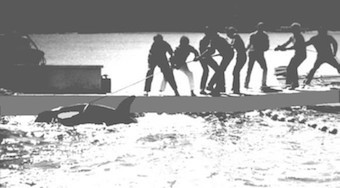The moment her freedom was stolen, over half a century ago
Photo Credit: One Green Planet – onegreenplanet.org
The show is finally over. After more than a half century of forced performances, the Miami Seaquarium has announced that Lolita will no longer be required to take part in shows. She is known as Tokitae to the people of the Salish Sea, from whose waters she was stolen in 1970 (and that is what I’ll call her through the rest of this post). Today she is one of the world’s best known orcas, and the second longest held in captivity.
The marine park’s new managers – Mexico-based theme park operator The Dolphin Company – also announced that she (and her Pacific white-sided dolphin companion) will no longer be on display or accessible to the public.
While this is good news, what’s been depicted in local media as Tokitae’s ‘retirement’ is anything but. Such a term implies that she had a choice in how her life was to play out. She isn’t retiring. Rather, she is no longer being compelled to entertain humans. We’re simply assigning a familiar term which describes a normal life lived by a sovereign individual. It doesn’t apply here, as her life was stolen from her. Further, while this orca is much beloved in the community, she is not a ‘resident’ of the Miami Seaquarium. She’s been one of its prisoners for over fifty years. Since she lost her freedom at the age of three or four, she has not been able to make a single decision about the course her life would take.
Tokitae has endured an existence which could not be more different from what it would have been had she been left free in the ocean, surrounded by other members of her pod. She hasn’t had the company of another orca since the death of her companion Hugo in 1980. Given her species nature and extraordinary social intelligence, this is heartbreaking beyond words. Also, all of her time in captivity has been in a tank which is less than four of her body lengths long, only 35 feet wide, and 20 feet deep. I don’t think I need to elaborate on how insanely cruel this is for an animal that in the wild swims 40 miles (64 kms) a day, and routinely dives up to 500 feet.
All with the constant company of other orcas.
These basic facts override everything else that has swirled around this story. The only question that really matters now is what the remainder of her life is going to look like. Once again, she won’t get to decide for herself. We’ll have to do the best we can to choose what’s best for her. To do what’s right.
Even if we could build a moral case for holding her captive – which we can’t – the conditions in which she’s been forced to live have at times been less than optimal. A USDA inspection cited a number of issues with water quality, facility maintenance and animal care. Their report dated July 6, 2022 detailed “critical” issues with the animals’ pools and enclosures, including poor water quality and inadequate shade. Multiple incidents of aggressive behavior were recorded, sometimes against trainers, at others with dolphins being injured when incompatible animals were housed together. It was also revealed that the diets of nine dolphins were severely curtailed to force better performance in shows and with guest interactions.
In one instance the animals were fed rotting fish, with trainers electing to ignore the advice of their veterinarian. In Tokitae’s case, her blood work showed inflammation as a result of at least eight days on a diet of this bad fish. As well, despite injury they continued to have her perform “head-in jumps” and other maneuvers that the facility’s vet told them she was simply too old to do. At another time the amount of fish she was provided each day was cut by a whopping 30 lbs.
It should not have come as a surprise when her failing health caused her to be placed on a 24-hour health watch last year. What’s interesting is that the concern for her wellbeing within the community and local media appeared to be entirely genuine. She’s been a fixture at the Seaquarium for a long time, and they see her as one of their own. I credit them with this compassion, but it’s all too easy to forget the unforgivably unjust actions that were taken to land her there in the first place.
Tokitae was taken from the Southern Resident orca population in the Pacific north-west, and is the longest living survivor of the the notorious Penn Cove captures of the 1960s and 70s (pictured above). Orcas would be rounded up and captured for sale to marine parks when hunters would throw noise makers into the water to herd them into a narrow area. There, the exit would be blocked and they’d begin to pull the babies and juvenile whales out of the water. One can scarcely imagine the trauma endured not only by these young animals, but by their parents and indeed by the entire pod. Tokitae is the last taken from these hunts who is still alive today.
To this day, a typical press release by her captors will read something as follows:
“Toki continues to undergo regular diagnostics to have the most complete and up to date understanding of her condition as possible. She is constantly monitored closely by her team of dedicated and loving caregivers. We will continue monitoring Toki in such a way, as we do with all our geriatric animals, and will provide an update if there is a noteworthy change in her status.”
That’s all very nice, and certainly what we’d expect at a minimum, but how about admitting that we should have just left her with her family where she belonged? In a show recorded last year, a trainer can be heard saying “Here at Miami Seaquarium, we’re proud to have all of you join us here to know that Lolita is happy and healthy.” We can gauge her health well enough, but what evidence do we have that she’s happy? After the mind-numbing routine of doing some version of the same show twice a day for over fifty years, how happy would you be?
Then, after alluding to her unusual longevity (in captivity), the show’s narrator states, , that “This makes Lolita a very special whale because she too was listed as a very special animal and serves as an ambassador for all whales, including the southern resident killer whale population.” Again, we’re playing fast and loose with language to make it sound like she had a choice. Ambassadors are generally not coerced. Nobody asked her if she wanted to spend a lifetime representing the orcas of the Salish Sea by performing stupid pet tricks for tourists, or trying to educate the public by displaying behaviours that would never be seen among her kind in the wild.
The entire thing is a farce, and let’s call it what it is. She has spent a lifetime earning millions for her captors. That’s exploitation. It’s the satisfaction of greed by depriving another individual of what was rightfully hers. There are no beneficiaries beyond the people who claim to own her. She isn’t an ambassador, and no one has been learning anything useful about how orcas live in their natural habitats.
The only question left that matters in this ongoing tragedy is where does she get to spend the rest of the time remaining to her. Groups fighting on her behalf have long advocated that she be returned to her home waters. This would be the most highly appropriate solution, as it would represent a homecoming in the truest sense. The people of the Lummi Nation refer to the Southern Residents as qwe ‘lhol mechen,’ or ‘our relations under the waters.’ They consider Tokitae a relative, one whose pain is mirrored within their community.
Sadly, concerns about her heath, along with the very fact that she’s been in captivity so long, may make such a return to her pod impossible. The skills she’s needed to survive as a captive orca are most emphatically not the skills she’d need to survive in the wild.
Another hopeful possibility is that she be released into a sanctuary. This is in fact probably our best option. The Whale Sanctuary Project has already prepared a complete operational plan for her transfer to the new facility to be opened at Port Hilford, NS. They’ve also begun discussions with other marine parks about the future status of whales who could be candidates for the sanctuary.
Included among these is Marineland Canada, at Niagara Falls, ON. It is my fondest hope that one day, some of that parks beluga whales can be relocated, along with their lone orca, Kiska. Like Tokitae, a long-time victim of unspeakable neglect and isolation from the company of other orcas. Perhaps at last the two of them can find some measure of peace in their final days.
For The Orca’s Voice,
Chris, Canadian Cetacean Alliance



Leave a Reply